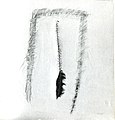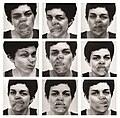Yocheved Weinfeld
A major contributor to this article appears to have a close connection with its subject. (March 2016) |

Yocheved (Juki) Weinfeld (born 1947) is an artist, museum educator and developer of interactive exhibitions for children. She studied at the Tel Aviv University and the State Art Teacher's College (Israel); at the Hebrew University of Jerusalem and at the Michaelis School of Art at the University of Cape Town in South Africa).
Weinfeld taught art at the
Weinfeld is considered one of the first Israeli artists to explore her heritage as a Jewish woman using contemporary means.[1] She exhibited her work in numerous one-woman shows in Israel since the 1970s (e.g., the Israel Museum, Bograshov Gallery, Gordon Gallery, Debel Gallery, Mabat Gallery). She also participated in many international group exhibitions in museums and galleries around the world.[2]
Her works are included in the collections of the Israel Museum in Jerusalem, the
Biography
Yocheved (Juki) Weinfeld (née Ewa Ernst) was born in 1947 in the Silesian city of
In 1957 the Ernst family emigrated to Israel, and after a few months in Tel-Aviv settled in Givatayim, a town near Tel-Aviv. While Ewa, now Yocheved, was considered an overall gifted child, her exceptional talents in drawing, acting and writing received particular attention.
At the age of 16 she was taken on as a student by the prominent Israeli artist and teacher, Raffi Lavie, and before she was 20, her works were being shown alongside her mentor's in exhibitions staged by the avant-garde group 10+. In 1979 she married David Weinfeld, then a Doctoral student at the Hebrew University in Jerusalem and an Orthodox Jew. In 1977 the marriage ended in divorce. In 1980, Weinfeld married Steven Kasher and moved to New York. In 1985 she gave birth to their daughter Talia Kasher. In 1993 the couple divorced.[3]
Art
In 1969 Weinfled exhibited her early paintings in a one-woman show in Mabat Gallery in Tel-Aviv. The paintings explored containments of biomorphic shapes (such as flesh) within geometric boundaries. The exhibition was met with disdain by most of the local art critics.
Over the next three years Weinfeld experimented with other juxtapositions of stylistic contrasts. Those were exhibited in numerous group shows, and eventually in 1972 in a one-woman show at the Bar-Kochba Gallery in Tel-Aviv. The exhibition met with mixed reviews. Reuven Berman wrote in The Jerusalem Post: "… Paintings based on internal stylistic and conceptual contrasts that break down fundamentally into a reasoned, studied, restrained approach on the one hand, and a spontaneous, gestural, painterly approach on the other… But the contrasts are lively and the show as a whole bears evidence of intellectual alertness…"
In 1973 following her mother's death and the Yom Kippur War, in an attempt to relinquish her facile drawings, and out of need to express her reaction to the scarred flesh and the scarred society, Weinfeld started experimenting with stitches on paper in lieu of pencil lines, and sometimes next to them. Some of those "drawings" were perceived as erotic and feminine, if not feminist. Stitching paper and canvas gave way to a renewed interest in flesh and body.
In 1974, in a one-woman show at the Debel Gallery in Jerusalem, Weinfeld —again interested in paradox– exhibited, among other works, a series of photographs of stitched hands and faces. These works that were in fact stitched photographs re-photographed, led way to works that became increasingly less concerned with esthetics or style and more conceptual in nature. The scarred, stitched "drawings" along with the stitched body parts, caused some critics to place Weinfeld's art within the Body-Art movement, and within it as feminist in nature.
In 1975, following her interest in
In 1976, after reading the
In 1979 Weinfeld's interest turned to primary images in memory and the ways they change and reoccur in subsequent memories. In her one-person show at the Israel Museum she exhibited ten large complex works, each based on a childhood memory represented by a text. Each work consisted of posed photographs of herself, three-dimensional objects and painted surfaces. Stephanie Rachum, the exhibition's curator wrote in the catalogue: "The deliberate disregard for the aesthetic aspect coupled with the stress on the ideational process which exist in Weinfeld's work is part of her Conceptual art background. --- This lack of transposing imbues the objects with vitality, energy and potency. --- Often the spectator feels that he has a 'direct line' to the sources that motivated or instigated the image."[5]
In the fall of 1979 Weinfeld moved to NY where she continued her work on complex memory pieces in the work "You look so typically Jewish"[6] and in the series "Stories for Little Children", exhibited at the Gordon Gallery in Tel-Aviv in 1981. The following year, Weinfeld experimented with posing figures painted in diverse styles in realistic scenes. The works, titled "Sentences" were exhibited at the Gordon Gallery in Tel-Aviv in 1982.
In 1991 Weinfeld exhibited two series of works, "Mother's Clichés," and "For the initiated history consists of just a few words." The exhibition, at the Bograshov Gallery in Tel-Aviv was curated by Ariella Azoulay Armon who wrote an essay in the accompanying catalogue.[7]
Gallery
-
1969, Mabat Gallery. Oil and pencil on linen. Private Collection
-
1973, Stitch with Feather. Thread, acrylic, pencil on linen. Private Collection
-
1974, Stitched Faces. One Person Show at Debel Gallery in Jerusalem. Stitched and rephotographed photographs. Collection: Haifa Museum of Art
-
1974, Stitched Hands. One Person Show at Debel Gallery in Jerusalem. Stitched and rephotographed photographs. Collection: Tel-Aviv Museum of Art
-
1974,One Person Show at Debel Gallery in Jerusalem. Mixed media on paper. Collection: Gordon Gallery
-
1974,One Person Show at Debel Gallery in Jerusalem. Mixed media on paper. Collection: Gordon Gallery
-
1975,"Pains" at Debel Gallery in Jerusalem. Pain in the Eyes. Mixed media. Collection: Haifa Museum of Art
-
1976, Documentation of a Performance during a one-person show at Debel Gallery in Jerusalem. Photographs.
-
1976, Stitched Faces. One Person Show at Debel Gallery in Jerusalem. Stitched and rephotographed photographs. Collection: Gordon Gallery
-
1976, Family Line. One Person Show at Debel Gallery in Jerusalem. Photographs, acrylic, pencil on paper
-
1979,Visual Images #8. Text: "In the concentration camps where all the Jews were dirty and hungry there were also beautiful women whom the Germans loved. So the women would beat Jews and get food. Now they are being punished. Their heads were shaven." One Person Show at the Israel Museum in Jerusalem. Mixed media. Collection: Israel Museum, Jerusalem
-
1979, Visual Images #7 (Mukkat Etz). Text: "Kazia and I are standing on the wooden veranda. Kazia sends me to buy cigarettes. Afterwards she gives me a puff and says, there was a girl in our village who played with a wooden stick between her legs and then blood came out I bleed from there every month. If a girl is pregnant a yellow juice comes out." Mixed media. One Person Show at the Israel Museum in Jerusalem. Private Collection
-
1980-81,Stories for Little Children. Text: "Don't worry they killed him on an electric chair it's the easiest death." One Person Show at the Gordon Gallery in Tel-Aviv. Artist's Collection
-
1980-81, Stories for Little Children. Text: "Eat eat in the war they even ate potato peels." One Person show at the Gordon Gallery in Tel-Aviv. Mixed media. Artist's Collection
-
1983-84,Oil on linen. Collection of the Artist
-
1988,Series: Mother's Cliches. Text: "You Will Always be my Baby." Mixed media. 1991, Bograshov Gallery, Tel-Aviv. Artist's Collection
-
1990, Series: "For the initiated it seems history consists of just a few words". Mixed media. 1991, Bograshov Gallery, Tel-Aviv. Private Collection
-
1993-94, Series: "What is What isn't. Bunny" Mixed media. Artist's Collection.
References
- ^ Sara Breitberg in Ari'el,issues 48-50,Ministry of Foreign Affairs, israel 1979. pp.55,63,64,65
- ^ Yona Fischer in Artists of Israel: 1920-1980, The Jewish Museum,1981.pp.57,58,142,143
- ^ Dr. Gannit Ankori: Yocheved Weinfeld’s Portraits of the Self in Woman’s Art Journal, Spring/Summer 1989[permanent dead link]
- ^ Ilana Tenenbaum,Catalog: Video Zero;performing the Body,Haifa Museum of Art,Haifa,2004,pp:7,33,34,41,42,64,65,66
- ^ Stephanie Rachum,Catalog:Yocheved Weinfeld,The Israel Museum, Jerusalem,1979
- ^ Ziva Amishai-Meizels,Depiction and Interpretation;Influence of the Holocaust on Visual Arts, Pergamon Press,1993.pp 362,363,366
- ^ Ariella Azoulay-Armon:"Mental Images have no Materiality" Catalog: Yocheved Weinfeld,Bograshov Gallery, 1991
















